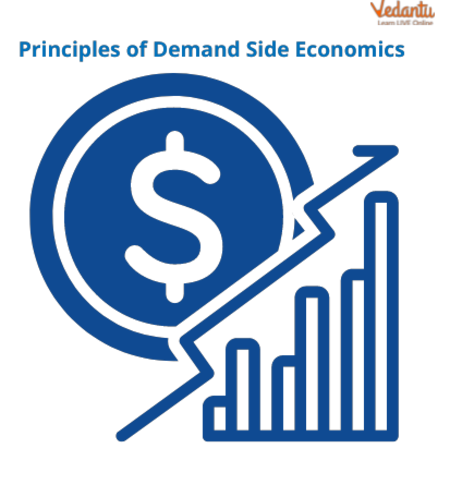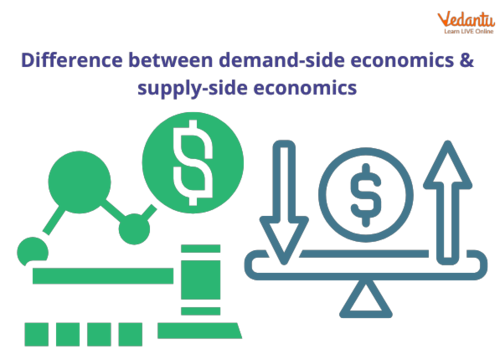




What is Demand Side Economics?
Demand-side economics is a school of economic thought that John Maynard Keynes established, arguing that economic growth is directly correlated with consumer demand for goods and services. This theory is also known as Keynesian economic theory. The demand for products and services, according to Keynesian economists, is what primarily drives economic activity and short-term fluctuations.
The emphasis on aggregate demand is one of the fundamental aspects of Keynesian economics or demand-side economics. Consumption of goods and services, industry investments in capital goods, governmental spending on public goods and services, and net exports comprise aggregate demand. Keynes emphasised that low demand for goods causes unemployment.
Demand Side Economics
Principles of Demand Side Economics

Principles of Demand Side Economics
The Keynesian explanation of how the economy functions are based on three main principles are as follows:
Prices, especially salaries, take time to adjust to changes in supply and demand, which frequently leads to labour shortages and surpluses.
Many economic decisions, both public and private, have an impact on aggregate demand. Private sector decisions can occasionally have a negative macroeconomic impact, such as a decrease in consumer spending during a recession. These market failures occasionally require active government actions, such as a fiscal stimulus package. Therefore, Keynesian economics favours a mixed economy run partly by the government and mainly under the direction of the private sector.
The immediate effects on real output and employment, not on the prices, resulting from changes in aggregate demand. However, it also includes a multiplier impact, when output varies by a factor of the change in spending (upward or downward) that created the change.
Difference Between Demand-side and Supply-side Economics

Difference Between Demand-side Economics and Supply-side Economics
Demand-side economics holds that consumers and their need for goods and services are the primary economic drivers, while it is not the same for supply-side economics. Let's have a look at a few differences between both of them:
Focus on Who Benefits From Tax Cuts: According to supply-side economics, tax relief is provided to corporations and the rich to encourage them to invest and fund business ventures. While demand-side economics focuses on giving tax cuts to lower- and middle-class people to encourage them to spend more on consumer products.
Emphasise Suppliers vs Consumers: Demand-side economics concentrates on the average consumer to support reviving the economy. On the other hand, the main goal of supply-side economics is to encourage prosperous consumer and company expenditure.
Give Customers More Options Rather Than More Money: Yet another way to distinguish between supply-side and demand-side economics is to consider the benefits they provide for customers. The objective of supply-side economics is to increase the number of goods and services available to consumers by encouraging companies to invest in production and research.
Demand-side economics, in comparison, is aimed at assisting consumers in increasing their income by lowering taxes so they can spend more on products and services.
Governmental Action: Demand-side economics emphasises the necessity and significance of public spending, infrastructure improvement, and new initiatives. On the contrary, supply-side economics places more of an emphasis on tax law. This is because reduced taxes encourage production, increasing commodity supply.
Summary
Supply and demand theory, or "comedian economics," is an approach that highlights the role that consumer demand plays in driving economic activity and generating variations. In contrast, producers' desire to deliver products and services determines supply-side economics. Monetary and fiscal policies are the two subcategories that make up demand-side policies. Variations in public spending and taxation are the primary concern of policymakers. Strategy for managing the money supply also includes measures to control the availability of credit and the cost of borrowing.
FAQs on Demand-Side Economics: Principles and Examples
1. What is demand-side economics?
Demand-side economics, also known as Keynesian economics, is a macroeconomic theory that argues economic growth is best stimulated by increasing the total demand for goods and services, known as aggregate demand. The core idea is that when consumers, businesses, and the government spend more, it drives production, creates jobs, and boosts the economy, especially during periods of recession.
2. What are the main tools used in demand-side economic policies?
The two primary tools for implementing demand-side policies are:
Fiscal Policy: This involves the government adjusting its spending and taxation. To boost demand, the government might increase spending on public projects (like infrastructure) or cut taxes to give households and businesses more disposable income to spend.
Monetary Policy: This is controlled by a country's central bank (e.g., the Reserve Bank of India). It involves managing the money supply and interest rates. Lowering interest rates makes borrowing cheaper, which encourages spending and investment, thereby stimulating demand.
3. What are some real-world examples of demand-side economics in action?
Notable examples of demand-side policies include:
The New Deal in the 1930s in the U.S., where President Roosevelt's government funded large-scale public works projects to combat unemployment during the Great Depression.
The 2008-2009 Global Financial Crisis response, where many governments, including India's, implemented stimulus packages involving increased government spending and lower interest rates to revive demand.
COVID-19 relief packages, where governments provided direct cash transfers, loan moratoriums, and other benefits to support household consumption when economic activity was stalled.
4. How does demand-side economics differ from supply-side economics?
The core difference lies in their focus. Demand-side economics aims to boost the economy by increasing consumer spending power (demand). In contrast, supply-side economics focuses on encouraging producers to increase the supply of goods by cutting corporate taxes and reducing regulation. Essentially, demand-side theory gives money to consumers to 'push' the economy, while supply-side theory gives incentives to businesses to 'pull' the economy forward through production.
5. Why is stimulating aggregate demand so important during a recession?
During a recession, an economy often falls into a vicious cycle of deficient demand. People lose jobs, so they spend less. Because people are spending less, businesses produce less and lay off more workers. Demand-side policies aim to break this cycle. By injecting spending into the economy, the government can create an initial boost in demand. This encourages businesses to increase production, hire more workers, and invest in the future, leading to a virtuous cycle of economic recovery and growth.
6. What are the main criticisms or potential drawbacks of demand-side policies?
While powerful, demand-side policies have potential drawbacks. The most significant criticism is the risk of causing inflation. If demand is stimulated too aggressively when the economy is already operating near its full capacity, it can lead to rising prices instead of more output. Another concern is the growth of government debt, as these policies often involve increased government spending and borrowing. Critics also argue that government spending can be inefficient and may not always be directed toward the most productive areas of the economy.
7. What is a 'demand-side shock' and how can it impact an economy?
A demand-side shock is a sudden, unexpected event that causes a significant change in aggregate demand. A negative shock, such as a global financial crisis or a pandemic, causes a sharp drop in consumer and business spending, leading to a recession and higher unemployment. A positive shock, such as a sudden asset boom or a large, unexpected tax cut, can rapidly increase demand, potentially leading to economic growth but also risking high inflation if supply cannot keep up.























